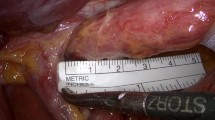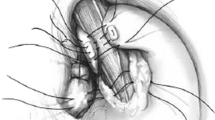Abstract
Background
Different methods have been described for laparoscopic hiatoplasty and hiatus hernia (HH) repair. All techniques are not standardized and the choice to reinforce or not the hiatus with a mesh is left to the operating surgeon’s preference. Hiatal surface area (HSA) has been described as an attempt at standardization; in case the area is > 4 cm2, a mesh is used to reinforce the repair.
Objective
The aim of this study was to describe a new patient-tailored algorithm (PTA), compare its performance in predicting crura mesh buttressing to HSA, and analyze outcomes.
Methods
Retrospective, single-center, descriptive study (September 2018–September 2021). Adult patients (≥ 18 years old) who underwent laparoscopic HH repair. Outcomes and quality of life measured with the disease-specific gastroesophageal reflux disease health-related quality of life (GERD-HRQL) and reflux symptom index (RSI) were analyzed.
Results
Fifty patients that underwent laparoscopic hiatoplasty and Toupet fundoplication were included. The median age was 61 years (range 32–83) and the median BMI was 26.7 (range 17–36). According to the PTA, 27 patients (54%) underwent simple suture repair while crural mesh buttressing with Phasix-ST® was used in 23 (46%). According to the HSA, the median hiatus area was 4.7 cm2 while 26 patients had an HSA greater than 4 cm2. The overall concordance rate between PTA and HSA was 94% (47/50). The median hospital stay was 1.9 days (range 1–8) and the 90-day complication rate was 4%. The median follow-up was 18.6 months (range 1–35). Hernia recurrence was diagnosed in 6%. Postoperative dysphagia occurred in one patient (2%). The GERD-HRQL (p < 0.001) and RSI (p = 0.001) were significantly improved.
Conclusions
The application of PTA for cruroplasty standardization in the setting of HH repair seems effective. While concordance with HSA is high, the PTA seems easier and promptly available in the operative theater with a potential increase in procedure standardization, reproducibility, and teaching.





Similar content being viewed by others
References
Soresi AL (1919) Diaphragmatic hernia: its unsuspected frequency, its diagnosis technic for radical cure. Annals of Surgery. 69(3):254–270
Harrington S (1928) Diaphragmatic hernia. Arch Surg. 16:386–415
Stylopoulos N, Rattner DW (2005) The history of hiatal hernia surgery: from Bowditch to laparoscopy. Annals of Surgery. 241(1):185–193
Dallemagne B, Weerts JM, Jehaes C, Markiewicz S, Lombard R (1991) Laparoscopic Nissen fundoplication: preliminary report. Surg Laparosc Endosc. 1(3):138–143
Granderath FA, Schweiger UM, Pointner R (2007) Laparoscopic antireflux surgery: tailoring the hiatal closure to the size of hiatal surface area. Surg Endosc 21(4):542–548
Aiolfi A, Cavalli M, Saino G, Sozzi A, Bonitta G, Micheletto G, et al. Laparoscopic posterior cruroplasty: a patient tailored approach. Hernia [Internet]. 2020 Apr 25 [cited 2022 Feb 4]; Available from: https://doi.org/10.1007/s10029-020-02188-5
Peters JH (2013) SAGES guidelines for the management of hiatal hernia. Surg Endosc. 27(12):4407–4408
for the SAGES Guidelines Committee, Kohn GP, Price RR, SR DM, Zehetner J, Muensterer OJ et al (2013) Guidelines for the management of hiatal hernia. Surg Endosc 27(12):4409–4428
Dindo D, Demartines N, Clavien P-A (2004) Classification of surgical complications: a new proposal with evaluation in a cohort of 6336 patients and results of a survey. Annals of Surgery 240(2):205–213
Velanovich V (1998) Comparison of generic (SF-36) vs. disease-specific (GERD-HRQL) quality-of-life scales for gastroesophageal reflux disease. Journal of Gastrointestinal Surgery 2(2):141–145
Porta A, Aiolfi A, Musolino C, Antonini I, Zappa MA (2017) Prospective comparison and quality of life for single-incision and conventional laparoscopic sleeve gastrectomy in a series of morbidly obese patients. Obes Surg 27(3):681–687. https://doi.org/10.1007/s11695-016-2338-2
Belafsky PC, Postma GN, Koufman JA (2002) Validity and reliability of the Reflux Symptom Index (RSI). Journal of Voice 16(2):274–277
Bona D, Aiolfi A, Asti E, Bonavina L (2020 Jun) Laparoscopic Toupet fundoplication for gastroesophageal reflux disease and hiatus hernia: proposal for standardization using the “critical view” concept. Updates Surg 72(2):555–558
Aiolfi A, Cavalli M, Sozzi A, Lombardo F, Lanzaro A, Panizzo V, et al. Medium-term safety and efficacy profile of paraesophageal hernia repair with Phasix-ST® mesh: a single-institution experience. Hernia [Internet]. 2021 30 [cited 2022 Feb 4]; Available from: https://doi.org/10.1007/s10029-021-02528-z
Core Team R (2018) R: a language and environment for statistical computing. R Foundation for Statistical Computing, Vienna, Austria
Reardon PR (2006) A modest proposal. Surg Endosc 20(6):995–995
Granderath FA (2007) Measurement of the esophageal hiatus by calculation of the hiatal surface area (HSA). Why, when and how? Surg Endosc 21(12):2224–2225
Siboni S, Asti E, Milito P, Bonitta G, Sironi A, Aiolfi A et al (2019) Impact of laparoscopic repair of large hiatus hernia on quality of life: observational cohort study. Dig Surg 36(5):402–408
Wade A, Dugan A, Plymale MA, Hoskins J, Zachem A, Roth JS (2016) Hiatal hernia cruroplasty with a running barbed suture compared to interrupted suture repair. Am Surg 82(9):e271–e274
Powell BS, Wandrey D, Voeller GR (2013) A technique for placement of a bioabsorbable prosthesis with fibrin glue fixation for reinforcement of the crural closure during hiatal hernia repair. Hernia. 17(1):81–84
Granderath FA (2003) Laparoscopic refundoplication with prosthetic hiatal closure for recurrent hiatal hernia after primary failed antireflux surgery. Arch Surg 1;138(8):902
Memon MA, Memon B, Yunus RM, Khan S (2016 Feb) Suture cruroplasty versus prosthetic hiatal herniorrhaphy for large hiatal hernia: a meta-analysis and systematic review of randomized controlled trials. Annals of Surgery 263(2):258–266
Memon MA, Siddaiah-Subramanya M, Yunus RM, Memon B, Khan S (2019) Suture cruroplasty versus mesh hiatal herniorrhaphy for large hiatal hernias (HHs): an updated meta-analysis and systematic review of randomized controlled trials. Surg Laparosc Endosc Percutan Tech 29(4):221–232
Petric J, Bright T, Liu DS, Wee Yun M, Watson DI (2022) Sutured versus mesh-augmented hiatus hernia repair: a systematic review and meta-analysis of randomized controlled trials. Annals of Surgery 275(1):e45–e51
Angeramo CA, Schlottmann F (2022) Laparoscopic paraesophageal hernia repair: to mesh or not to mesh. Systematic review and meta-analysis. Annals of Surgery 275(1):67–72
Fourtanier G (2007) A new method to calibrate the hiatus. Surg Endosc 21(9):1674–1675
Grubnik VV, Malynovskyy AV (2013) Laparoscopic repair of hiatal hernias: new classification supported by long-term results. Surg Endosc 27(11):4337–4346
Koch OO, Asche KU, Berger J, Weber E, Granderath FA, Pointner R (2011) Influence of the size of the hiatus on the rate of reherniation after laparoscopic fundoplication and refundopilication with mesh hiatoplasty. Surg Endosc 25(4):1024–1030
Endzinas Z, Jonciauskiene J, Mickevicius A, Kiudelis M (2007) Hiatal hernia recurrence after laparoscopic fundoplication. Medicina (Kaunas) 43(1):27–31
Little AG, Ferguson MK, Skinner DB (1986) Reoperation for failed antireflux operations. J Thorac Cardiovasc Surg 91(4):511–517
Fei L, del Genio G, Brusciano L, Esposito V, Cuttitta D, Pizza F et al (2007) Crura ultrastructural alterations in patients with hiatal hernia: a pilot study. Surg Endosc 21(6):907–911
Fei L, del Genio G, Rossetti G, Sampaolo S, Moccia F, Trapani V et al (2009) Hiatal hernia recurrence: surgical complication or disease? Electron Microscope Findings of the Diaphragmatic Pillars. J Gastrointest Surg 13(3):459–464
Håkanson BS, Lundell L, Bylund A, Thorell A (2019) Comparison of laparoscopic 270° posterior partial fundoplication vs total fundoplication for the treatment of gastroesophageal reflux disease: a randomized clinical trial. JAMA Surg 154(6):479
Broeders JAJL, Mauritz FA, Ahmed Ali U, Draaisma WA, Ruurda JP, Gooszen HG et al (2010) Systematic review and meta-analysis of laparoscopic Nissen (posterior total) versus Toupet (posterior partial) fundoplication for gastro-oesophageal reflux disease. British Journal of Surgery 97(9):1318–1330
Panici Tonucci T, Asti E, Sironi A, Ferrari D, Bonavina L (2020) Safety and Efficacy of Crura Augmentation with Phasix ST Mesh for Large Hiatal Hernia: 3-Year Single-Center Experience. J Laparoendosc Adv Surg Tech A 30(4):369–372. https://doi.org/10.1089/lap.2019.0726 Epub 2020 Jan 7
Niebisch S, Fleming FJ, Galey KM, Wilshire CL, Jones CE, Litle VR, Watson TJ, Peters JH (2012) Perioperative risk of laparoscopic fundoplication: safer than previously reported-analysis of the American College of Surgeons National Surgical Quality Improvement Program 2005 to 2009. J Am Coll Surg 215(1):61–68; discussion 68-9. https://doi.org/10.1016/j.jamcollsurg.2012.03.022
Bizekis C, Kent M, Luketich J (2006) Complications after surgery for gastroesophageal reflux disease. Thorac Surg Clin 16(1):99–108. https://doi.org/10.1016/j.thorsurg.2006.01.010
Asti E, Asti E, Lovece A, Bonavina L, Milito P, Sironi A, Bonitta G, Siboni S (2016) Laparoscopic management of large hiatus hernia: five-year cohort study and comparison of mesh-augmented versus standard crura repair. Surg Endosc 30(12):5404
Rodríguez-Luna MR, Pizzicannella M, Fiorillo C, Almuttawa A, Lapergola A, Mutter D, Marrescaux J, Dallemagne B, Perretta S (2021) Impact of surgical repair on type IV paraesophageal hernias (PEHs). Surg Endosc. https://doi.org/10.1007/s00464-021-08828-w
Patel NM, Puri A, Sounderajah V, Ferri L, Griffiths E, Low D, Maynard N, Mueller C, Pera M, van Berge Henegouwen MI, Watson DI, Zaninotto G, Hanna GB, Markar SR (2021) Para-Oesophageal hernia Symptom Tool (POST) Collaborative. Quality of life and symptom assessment in paraesophageal hernias: a systematic literature review of reporting standards. Dis Esophagus 12;34(7):doaa134
Author information
Authors and Affiliations
Corresponding author
Ethics declarations
Ethical approval
All procedures performed in the studies involving human participates were in accordance with the ethical standards of the institution and/or national research committee and with the 1964 Helsinki Declaration and its later amendments or comparable ethical standards.
Ethical standards
Appropriate Institutional Board Review approval was obtained for the study.
Human and animal rights
The procedures performed in this study are approved procedures for daily practice, and this descriptive retrospective study therefore does not include experiments on humans.
Informed consent
Patients were requested to sign the written informed consent.
Conflict of interest
The authors declare no competing interests.
Additional information
Publisher’s note
Springer Nature remains neutral with regard to jurisdictional claims in published maps and institutional affiliations.
Supplementary Information
Rights and permissions
About this article
Cite this article
Aiolfi, A., Sozzi, A., Cavalli, M. et al. Patient-tailored algorithm for laparoscopic cruroplasty standardization: comparison with hiatal surface area and medium-term outcomes. Langenbecks Arch Surg 407, 2537–2545 (2022). https://doi.org/10.1007/s00423-022-02556-y
Received:
Accepted:
Published:
Issue Date:
DOI: https://doi.org/10.1007/s00423-022-02556-y




